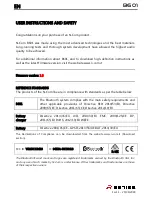
Radar based Blind Spot Information System
MBHL TypA Operating & Integration Manual
Remarks:
Certification Documentation
Revision:
2.1
Date:
12/12/2011
Page:
22 of 29
VALEO-RADAR SYSTEMS, INC.
Laiernstr. 12, D-74321 Bietigheim-Bissingen / Germany
+ 49 (+7142) 916 – 0
+ 49 (+7142) 916 – 4000
This document is the exclusive property of Valeo-Raytheon System, Inc.
It cannot be communicated or divulged to anybody without a previous written authorization.
4.1.3.7.1. Serial data induced fault conditions
The BSD system shall be disabled if any of the following conditions occurs:
•
Invalidated signal: a CAN signal, monitored for validity, is invalid (validity
signal set to invalid). Validity signals to be monitored have to be specified in
the “target vehicle” CAN database.
•
Loss of transmission: a required CAN signal is not available or has not been
received according to LOSS OF TRANSMISSION timeout. The signals to
be monitored for loss of are specified in the “target vehicle” CAN database.
4.1.3.8. STANDBY state
The STANDBY state shall be entered when the vehicle is in park or reverse, or
when the parking brake is set. Radar transmission to monitor the field of view is
not performed while in this state.
4.1.3.9. SYSTEM ACTIVE state
In this state, the field of view of the sensor is constantly monitored.
4.1.4. HMI output function
Each sensor has CAN signals for independently controlling an alert display and a
status message. Each rBLIS Sensor provides independent displays for its own
side of the vehicle. No other directly controlled (e.g. audible) alert will be provided.
4.1.5. CAN communication
CAN communication shall be provided through a two wire transceiver, compliant
with the specifications listed in section 2.3. The required CAN messages, CAN-ID
and DTC will be specified by the OEMs.







































